新目标九年级下册英语教材分析Unit3
- 格式:doc
- 大小:82.50 KB
- 文档页数:7
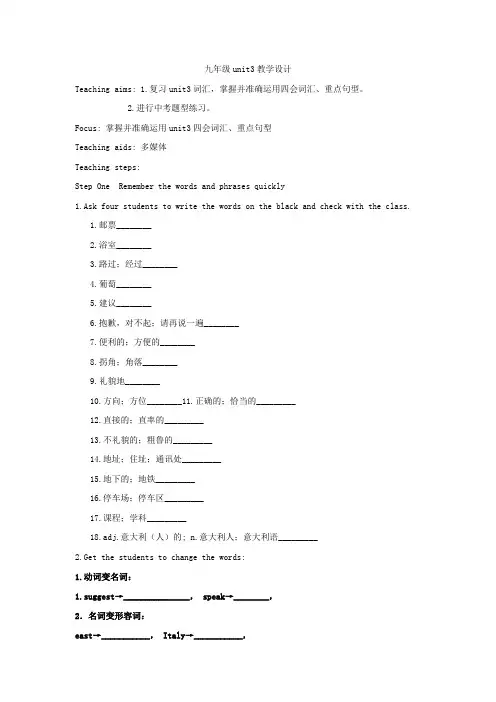
九年级unit3教学设计Teaching aims: 1.复习unit3词汇,掌握并准确运用四会词汇、重点句型。
2.进行中考题型练习。
Focus: 掌握并准确运用unit3四会词汇、重点句型Teaching aids: 多媒体Teaching steps:Step One Remember the words and phrases quickly1.Ask four students to write the words on the black and check with the class.1.邮票________2.浴室________3.路过;经过________4.葡萄________5.建议________6.抱歉,对不起;请再说一遍________7.便利的;方便的________8.拐角;角落________9.礼貌地________10.方向;方位________11.正确的;恰当的_________12.直接的;直率的_________13.不礼貌的;粗鲁的_________14.地址;住址;通讯处_________15.地下的;地铁_________16.停车场;停车区_________17.课程;学科_________18.adj.意大利(人)的; n.意大利人;意大利语_________2.Get the students to change the words:1.动词变名词:1.suggest→_______________, speak→________,2.名词变形容词:east→___________, Italy→___________,3.反义词(加词缀):polite→____________, direct→_______________3.Let the students write the phrases and read aloud.1. a________ of 一对/双/副/……2.________ one's left/right 在某人的左/右边3.________…and… 在……(两者)之间4. ________ one's way ________…在某人去……的路上5. pass________ 路过6. get ________ 到达7.________ me 什么;请再说一次8. depend ________ 依赖;取决于9.________ lot 停车场10. lead in ________ 导入11. the ________ of ……的角落12. be ________ a ________ (to do sth.)匆忙(做某事)13. look forward ________ 盼望;期待14. ________ the________ time 第一次15. ________ the third________ 在三楼16.________ right 向右转Step Two Wtite and remember the sentencesAsk the students to finish the sentences and remember them.1.打扰一下,你能告诉我怎样到书店吗?Excuse me, could you please tell me ________ ________ ________ to the bookstore? 2.我想知道接下来我们应该去哪里。
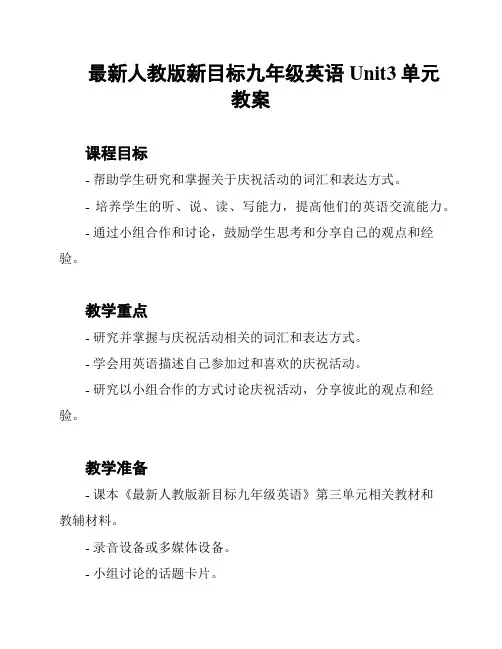
最新人教版新目标九年级英语Unit3单元教案课程目标- 帮助学生研究和掌握关于庆祝活动的词汇和表达方式。
- 培养学生的听、说、读、写能力,提高他们的英语交流能力。
- 通过小组合作和讨论,鼓励学生思考和分享自己的观点和经验。
教学重点- 研究并掌握与庆祝活动相关的词汇和表达方式。
- 学会用英语描述自己参加过和喜欢的庆祝活动。
- 研究以小组合作的方式讨论庆祝活动,分享彼此的观点和经验。
教学准备- 课本《最新人教版新目标九年级英语》第三单元相关教材和教辅材料。
- 录音设备或多媒体设备。
- 小组讨论的话题卡片。
教学过程导入(5分钟)- 利用多媒体设备播放相关庆祝活动的图像或视频,引起学生的兴趣和好奇心。
情境导入(10分钟)- 指导学生利用课本中的对话,进行口语对话练,研究和复与庆祝活动相关的词汇和句型。
听力训练(15分钟)- 播放英语听力材料,让学生听取庆祝活动的相关信息,并回答相关问题。
阅读练(15分钟)- 学生分组阅读相关庆祝活动的篇章,理解并回答问题。
口语表达(15分钟)- 学生利用小组讨论的话题卡片,就自己参加过和喜欢的庆祝活动进行交流和表达意见。
写作练(15分钟)- 学生就自己参加过的庆祝活动或对未来庆祝活动的期望进行书面表达。
小结(5分钟)- 复当天所学的庆祝活动的词汇、句型和表达方式。
教学延伸- 鼓励学生在课后进行更多的英语听力、阅读和写作练,扩充他们的英语能力。
教学评价- 观察学生在课堂上的口语表达和书面表达能力,并及时给予反馈和指导。
- 批改学生的作业,评估他们对庆祝活动的理解和运用能力。
参考资料- 《最新人教版新目标九年级英语》教材和教辅材料。
- 相关的英语听力和阅读材料。
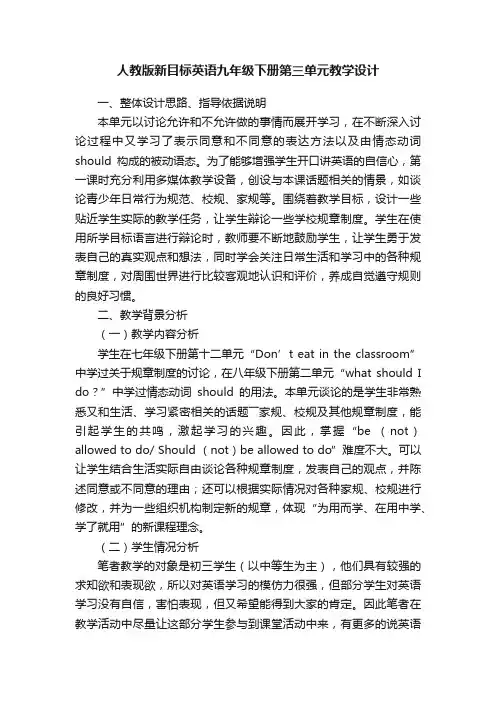
人教版新目标英语九年级下册第三单元教学设计一、整体设计思路、指导依据说明本单元以讨论允许和不允许做的事情而展开学习,在不断深入讨论过程中又学习了表示同意和不同意的表达方法以及由情态动词should构成的被动语态。
为了能够增强学生开口讲英语的自信心,第一课时充分利用多媒体教学设备,创设与本课话题相关的情景,如谈论青少年日常行为规范、校规、家规等。
围绕着教学目标,设计一些贴近学生实际的教学任务,让学生辩论一些学校规章制度。
学生在使用所学目标语言进行辩论时,教师要不断地鼓励学生,让学生勇于发表自己的真实观点和想法,同时学会关注日常生活和学习中的各种规章制度,对周围世界进行比较客观地认识和评价,养成自觉遵守规则的良好习惯。
二、教学背景分析(一)教学内容分析学生在七年级下册第十二单元“Don’t eat in the classroom”中学过关于规章制度的讨论,在八年级下册第二单元“what should I do?”中学过情态动词should的用法。
本单元谈论的是学生非常熟悉又和生活、学习紧密相关的话题――家规、校规及其他规章制度,能引起学生的共鸣,激起学习的兴趣。
因此,掌握“be (not)allowed to do/ Should (not)be allowed to do”难度不大。
可以让学生结合生活实际自由谈论各种规章制度,发表自己的观点,并陈述同意或不同意的理由;还可以根据实际情况对各种家规、校规进行修改,并为一些组织机构制定新的规章,体现“为用而学、在用中学、学了就用”的新课程理念。
(二)学生情况分析笔者教学的对象是初三学生(以中等生为主),他们具有较强的求知欲和表现欲,所以对英语学习的模仿力很强,但部分学生对英语学习没有自信,害怕表现,但又希望能得到大家的肯定。
因此笔者在教学活动中尽量让这部分学生参与到课堂活动中来,有更多的说英语的机会,增强他们的自信心;还有一些学困生由于基础薄弱,对完成某些任务有一定的难度,教师可采取小组奖励的办法,通过学生间的合作学习,促进小组成员之间的互帮互学,鼓励小组中的优秀成员主动帮助困难生学习,培养学生的团队意识。
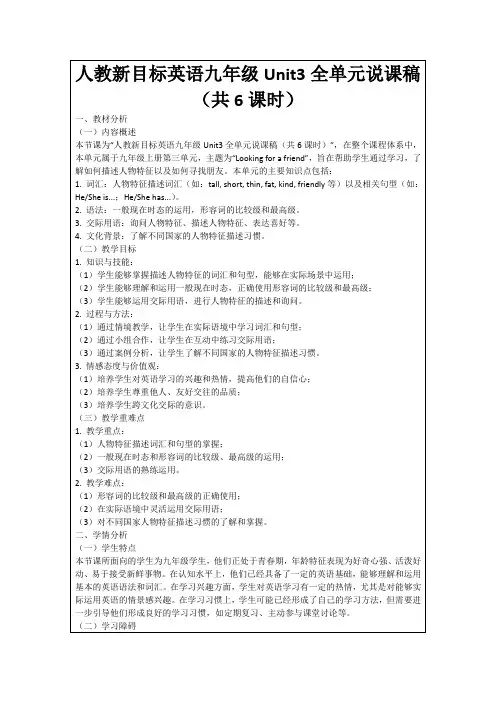
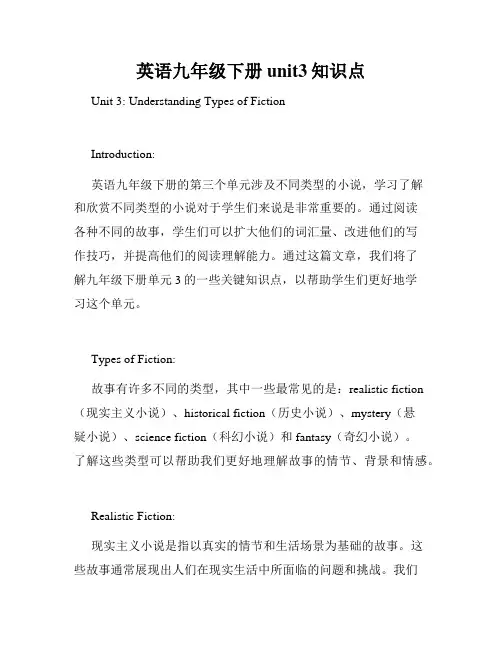
英语九年级下册unit3知识点Unit 3: Understanding Types of FictionIntroduction:英语九年级下册的第三个单元涉及不同类型的小说,学习了解和欣赏不同类型的小说对于学生们来说是非常重要的。
通过阅读各种不同的故事,学生们可以扩大他们的词汇量、改进他们的写作技巧,并提高他们的阅读理解能力。
通过这篇文章,我们将了解九年级下册单元3的一些关键知识点,以帮助学生们更好地学习这个单元。
Types of Fiction:故事有许多不同的类型,其中一些最常见的是:realistic fiction (现实主义小说)、historical fiction(历史小说)、mystery(悬疑小说)、science fiction(科幻小说)和fantasy(奇幻小说)。
了解这些类型可以帮助我们更好地理解故事的情节、背景和情感。
Realistic Fiction:现实主义小说是指以真实的情节和生活场景为基础的故事。
这些故事通常展现出人们在现实生活中所面临的问题和挑战。
我们可以从这些故事中学到很多关于人类行为、社会文化和人际关系的知识。
Historical Fiction:历史小说是以历史事件、人物和时代为背景的故事。
通过阅读这些小说,我们可以了解到过去的文化、社会和生活方式,以及历史事件对个人和社会的影响。
了解历史小说也可以帮助我们更好地理解和重建历史。
Mystery:悬疑小说是指通过引入秘密、谜题和解谜过程来吸引读者的一类小说。
这些故事让读者试图解开故事中的谜团,了解真相和背后的动机。
悬疑小说可以帮助我们锻炼逻辑思维和推理能力,并提高我们的阅读理解能力。
Science Fiction:科幻小说是以科学理论和科技为基础的虚构故事。
这些故事通常设定在未来或者不同的星球上,通过想象未来的科技发展和社会变革来探讨人类面临的挑战和问题。
科幻小说可以帮助我们发散思维,拓宽我们的想象力,并让我们思考科技对社会和人类的影响。

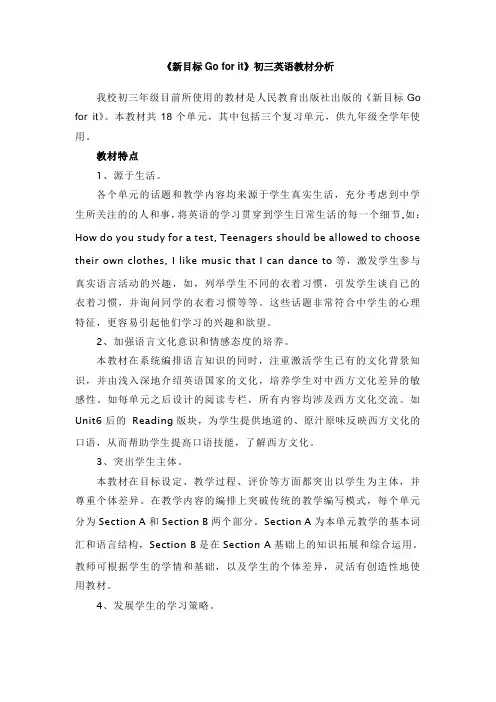
《新目标Go for it》初三英语教材分析我校初三年级目前所使用的教材是人民教育出版社出版的《新目标Go for it》。
本教材共18个单元,其中包括三个复习单元,供九年级全学年使用。
教材特点1、源于生活。
各个单元的话题和教学内容均来源于学生真实生活,充分考虑到中学生所关注的的人和事,将英语的学习贯穿到学生日常生活的每一个细节,如:How do you study for a test, Teenagers should be allowed to choose their own clothes, I like music that I can dance to等,激发学生参与真实语言活动的兴趣,如,列举学生不同的衣着习惯,引发学生谈自己的衣着习惯,并询问同学的衣着习惯等等。
这些话题非常符合中学生的心理特征,更容易引起他们学习的兴趣和欲望。
2、加强语言文化意识和情感态度的培养。
本教材在系统编排语言知识的同时,注重激活学生已有的文化背景知识,并由浅入深地介绍英语国家的文化,培养学生对中西方文化差异的敏感性。
如每单元之后设计的阅读专栏,所有内容均涉及西方文化交流。
如Unit6后的Reading版块,为学生提供地道的、原汁原味反映西方文化的口语,从而帮助学生提高口语技能,了解西方文化。
3、突出学生主体。
本教材在目标设定、教学过程、评价等方面都突出以学生为主体,并尊重个体差异。
在教学内容的编排上突破传统的教学编写模式,每个单元分为Section A和Section B两个部分。
Section A为本单元教学的基本词汇和语言结构,Section B是在Section A基础上的知识拓展和综合运用。
教师可根据学生的学情和基础,以及学生的个体差异,灵活有创造性地使用教材。
4、发展学生的学习策略。
此教材在编写的体例设计、教学过程的实施等方面,侧重于学生学习能力的【培养,在学习的每个阶段考虑到学生需求,重视培养学生“学会学习”的能力。
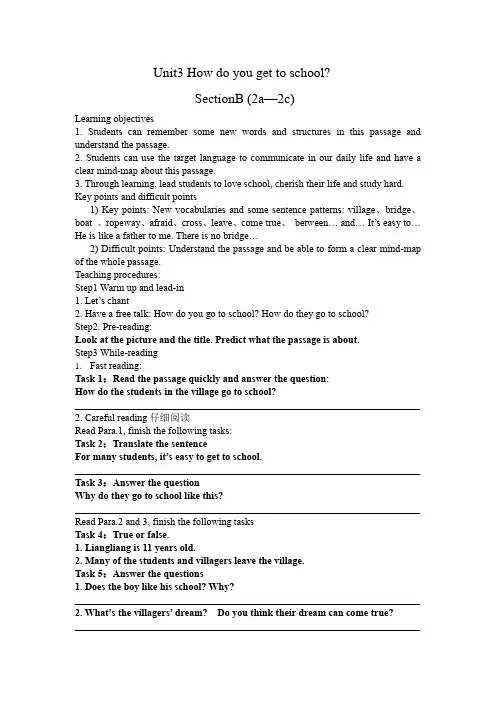
Unit3 How do you get to school?SectionB (2a—2c)Learning objectives1. Students can remember some new words and structures in this passage and understand the passage.2. Students can use the target language to communicate in our daily life and have a clear mind-map about this passage.3. Through learning, lead students to love school, cherish their life and study hard. Key points and difficult points1) Key points: New vocabularies and some sentence patterns: village、bridge、boat 、ropeway、afraid、cross、leave、come true、between… and… It’s easy to… He is like a father to me. There is no bridge…2) Difficult points: Understand the passage and be able to form a clear mind-map of the whole passage.Teaching procedures:Step1 Warm up and lead-in1. Let’s chant2. Have a free talk: How do you go to school? How do they go to school?Step2. Pre-reading:Look at the picture and the title. Predict what the passage is about.Step3 While-reading1.Fast reading:Task 1:Read the passage quickly and answer the question:How do the students in the village go to school?_____________________________________________________________________ 2. Careful reading仔细阅读Read Para.1, finish the following tasks:Task 2:Translate the sentenceFor many students, it’s easy to get to school._____________________________________________________________________ Task 3:Answer the questionWhy do they go to school like this?_____________________________________________________________________ Read Para.2 and 3, finish the following tasksTask 4:True or false.1. Liangliang is 11 years old.2. Many of the students and villagers leave the village.Task 5:Answer the questions1. Does the boy like his school? Why?_____________________________________________________________________ 2. What’s the villagers’ dream? Do you think their dream can come true?_____________________________________________________________________3.Discussion(讨论)How can their dream come true?What can we do?What can they do?Their dream can come true if(如果) people around the world(世界各地的人们)help them.By discussing the answers of the questions, it can improve their ability of cooperation.4. Read the passage again. Complete the sentences with the words from the passage.1) For the students in the village, it is ________ to get to the school.2) They have to cross a very _____ river between their school and the village.3) They cannot go by boat because the river runs too _________.4) It is not easy to cross the river on a ropeway, but the boy is not _______.5) The students and villagers want to have a bridge. Can their dream come _____? 5. ListeningListen and repeat, try to imitate the pronunciation and intonation.Step4.Post-reading:Retell the whole passage according to the mind-map.For many students-----It’s easy to get to schoola big river between…difficult no bridge so……For the students inone small village the river runs quicklyone 11-year-old boyLiangliangis is not afraidloves schoolDream------have a bridge-----come trueRewritingComplete the passage without looking at your own books.Life is precious(宝贵的). We should cherish our good life now.(珍惜现有的生活)Step7.Homework1. For all: Finish the exercise and preview 3a and 3b.2. Optional: Write a letter to the village students and tell them the way you get to school and what you want to do for them.Unit 3 How do you get to school?学情分析Section B (2a-2c)七年级下册教材内容,较七年级上册内容比,英语知识点深入,而且我们这里的学生地处比较偏远的农村地区,各种条件相对比较落后。
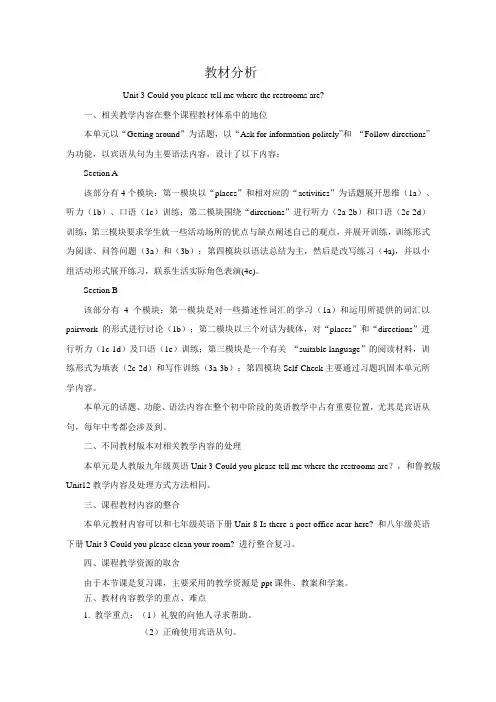
教材分析Unit 3 Could you please tell me where the restrooms are?一、相关教学内容在整个课程教材体系中的地位本单元以“Getting around”为话题,以“Ask for information politely”和“Follow directions”为功能,以宾语从句为主要语法内容,设计了以下内容:Section A该部分有4个模块:第一模块以“places”和相对应的“activities”为话题展开思维(1a)、听力(1b)、口语(1c)训练;第二模块围绕“directions”进行听力(2a-2b)和口语(2c-2d)训练;第三模块要求学生就一些活动场所的优点与缺点阐述自己的观点,并展开训练,训练形式为阅读、问答问题(3a)和(3b);第四模块以语法总结为主,然后是改写练习(4a),并以小组活动形式展开练习,联系生活实际角色表演(4c)。
Section B该部分有4个模块:第一模块是对一些描述性词汇的学习(1a)和运用所提供的词汇以pairwork的形式进行讨论(1b);第二模块以三个对话为载体,对“places”和“directions”进行听力(1c-1d)及口语(1e)训练;第三模块是一个有关“suitable language”的阅读材料,训练形式为填表(2c-2d)和写作训练(3a-3b);第四模块Self Check主要通过习题巩固本单元所学内容。
本单元的话题、功能、语法内容在整个初中阶段的英语教学中占有重要位置,尤其是宾语从句,每年中考都会涉及到。
二、不同教材版本对相关教学内容的处理本单元是人教版九年级英语Unit 3 Could you please tell me where the restrooms are?,和鲁教版Unit12教学内容及处理方式方法相同。
三、课程教材内容的整合本单元教材内容可以和七年级英语下册Unit 8 Is there a post office near here? 和八年级英语下册Unit 3 Could you please clean your room? 进行整合复习。
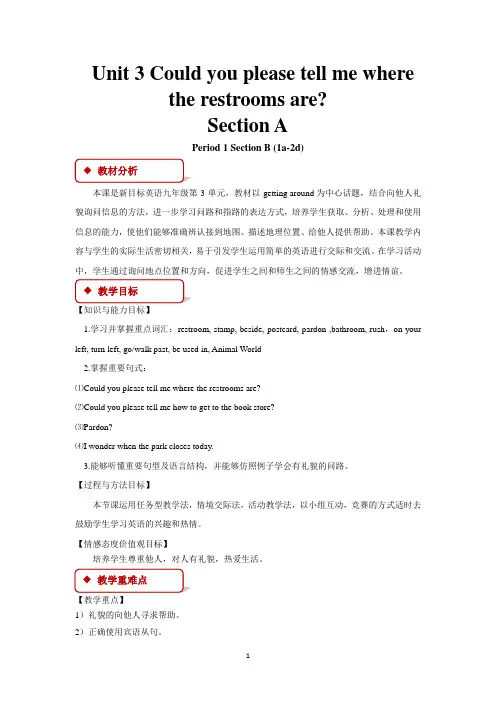
Unit 3 Could you please tell me wherethe restrooms are?Section A Period 1 Section B (1a-2d)本课是新目标英语九年级第3单元,教材以getting around 为中心话题,结合向他人礼貌询问信息的方法,进一步学习问路和指路的表达方式,培养学生获取、分析、处理和使用信息的能力,使他们能够准确辨认接到地图、描述地理位置、给他人提供帮助。
本课教学内容与学生的实际生活密切相关,易于引发学生运用简单的英语进行交际和交流。
在学习活动中,学生通过询问地点位置和方向,促进学生之间和师生之间的情感交流,增进情谊。
【知识与能力目标】1.学习并掌握重点词汇:restroom, stamp, beside, postcard, pardon ,bathroom, rush ,on your left, turn left, go/walk past, be used in, Animal World2.掌握重要句式:⑴Could you please tell me where the restrooms are? ⑵Could you please tell me how to get to the book store? ⑶Pardon?⑷I wonder when the park closes today.3.能够听懂重要句型及语言结构,并能够仿照例子学会有礼貌的问路。
【过程与方法目标】本节课运用任务型教学法,情境交际法,活动教学法,以小组互动,竞赛的方式适时去鼓励学生学习英语的兴趣和热情。
【情感态度价值观目标】培养学生尊重他人,对人有礼貌,热爱生活。
【教学重点】1)礼貌的向他人寻求帮助。
2)正确使用宾语从句。
【教学难点】运用宾语从句礼貌的寻求帮助。
2.设计课后巩固练习;3.ppt;Section A (1a-2d)Step 1. Warm –upGreetings.Step 2. Presentation(1)Guessing gameShow pictures to the whole class, one student explains the places in English and another one who doesn’t look at the blackboard guesses what place it is. For example, one student say: We can save money or exchange money in this place, another one guess it is a bank. Get students to guess the places like bank, post office, bookstore, museum, bathroom, washroom, mall and so on.(2)Show some stamps to students and present the new sentences:Could you tell me where I can buy some stamps?Could you please tell me where I can get a dictionary?Do you know where I can get some magazines?Step 3. Practice1)Match each thing with a place in the picture in 1a.2)Read the phrases.___ get some money___ get some magazines___ have dinner___ get a dictionary___ get some information about the town___ buy a newspaper___ buy some stamps___ get a pair of shoesStep 4. ListeningListen and complete the conversations in the picture in 1a. Then check the answers with the whole class.Step 5. PracticeMake conversations using the information in 1a. Then talk about your own city. For example:A: Excuse me, could you please tell me how to get to the bookstore?B: Sure, just go along Main Street until you pass Center Street. The bookstore is on your right, beside the bank.A: Thanks. Do you know when the bookstore closes today?B: It closes at 7:00 p.m. today.A: Thank you!B: You’re welcome.Step 6. Listening1. Listen and number the directions in the order that you hear them.2a You will hear some of the directions below. Number the directions in the order you hear them.___ Go to the bird floor.___ Turn left.___ Go to the second floor.___ Turn right.___ The supermarket is between the flower store and the bookstore.___ Go past the bookstore.2. Listen again. Show how the boy walks to the supermarket. Draw a line in the picture in 2a. Then get one student draw the line on the blackboard.3. Listen for a third time and answer the questions.1) Excuse me, can you tell me where I can buy some medicine?2) Do you know how to go there?3) OK, great. Oh, and one more thing. Do you know when this shopping center closes tonight?4) OK, thanks a lot.Step 7. Pair workMake conversations about the other places in the picture in 2a.A: Excuse me. Can you tell me where I can buy some stamps?B: Yes, there’s a post office in this shopping center.A: Do you know how to go there?B: Yes. Go to the third floor and turn right. Then go past the bank. The post office is between museum and library. You should be able to get stamps.A: OK, great. Oh, and one more thing. Do you know …B: I’m not sure, but you …A: OK, thanks a lot.B: You’re welcome.Step 8. Reading1. Read the conversation in 2d and answer the questions.2. Role – play the conversation.3. Explain the language pints in 2d.(1) Go along Main Street until you pass Center Street.1) until和 till同义为“直到……” ,till多用于口语,until可以放在句首,till则不能放在句首。
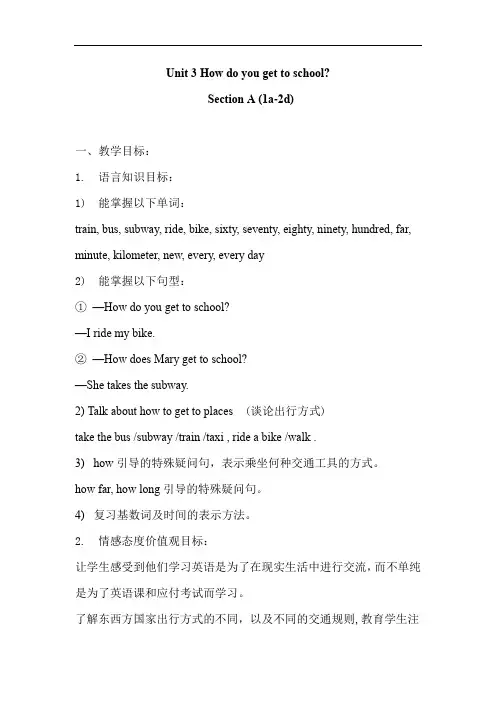
Unit3How do you get to school?Section A(1a-2d)一、教学目标:1. 语言知识目标:1) 能掌握以下单词:train,bus,subway,ride,bike,sixty,seventy,eighty,ninety,hundred,far, minute,kilometer,new,every,every day2) 能掌握以下句型:①—How do you get to school?—I ride my bike.②—How does Mary get to school?—She takes the subway.2) Talk about how to get to places(谈论出行方式)take the bus/subway/train/taxi,ride a bike/walk.3) how引导的特殊疑问句,表示乘坐何种交通工具的方式。
how far,how long引导的特殊疑问句。
4) 复习基数词及时间的表示方法。
2. 情感态度价值观目标:让学生感受到他们学习英语是为了在现实生活中进行交流,而不单纯是为了英语课和应付考试而学习。
了解东西方国家出行方式的不同,以及不同的交通规则,教育学生注意交通安全, 加深对交通知识的了解。
倡导自觉遵守交通法规及礼貌,构建和谐的人际关系。
了解交通的发展,培养创新精神。
二、教学重难点1. 教学重点:1)how/how far/how long引导的特殊疑问句.2) 乘坐交通工具的表示方法.3)It takes/sb some time to do sth.2.教学难点:—How do you get to school?—I take the…/ride…/walk…—How does Mary get to school?—She takes the subway.—How long does it take?—It takes forty minutes.—How far is it from…to…—It's…kilometers.三、教学过程Ⅰ.Warming-up and Lead in学生和老师进行简单的问候Ss:Good morning,teacher.T:Good morning,classT:Look at the picture.What can you see?Do you like your school?I usually get to school by b ike,butsometimes on foot.How do you get to school?Ss按实际情况作答S1:I ride my bike.S2:I go by bus.S3:………T:Very good.You’re clever.Let’s learn Unit4Section A.Ⅱ.Presentation1.T:If you are here,but your school is in Shanghai.How do you get to sc hool?Ss:I take the bus/plane/boat/ship/car/taxi I ride a bike/motorbike T:Do you know any other way?2.Teacher shows pictures on the big screen.归纳出行方式和常用短语.Ask some questions about how you get to…?(让学生积极主动的思考想象总结,多媒体增加趣味性,加强直观性,效果事半功倍)3.Show a picture about Part1,on the screen.Point at girls or boys in the picture.Ask students to answer and write in the blanks.S1:How does he/she go to school?S2:He/She……Ⅲ.1aT:Look at the picture on your book.Match the words with the picture.(学生们完成1a的学习任务,然后校对答案)Ⅳ.Listening1.Make sure the Ss know what to do.Give them an example orally if pos sible.2.Read the names in the box.3.Play the tape and check the answers.Ⅴ.Pair workAsk two students to read the dialogue in the speech bubbles to the class. Then askstudents to work in pairs.Ask and answer how students get to school in th e picture.Finally ask some pairs of students to present their conversations to the cla ss.Ⅵ.Listening1.Revise the numbers,first,zero~nine,next,ten~nineteen,then,twenty,t hirty,forty…finally,twenty-one,twenty-two…Teach the new word"hun dred".2.Play the tape for the students to finish2a.Then play again and check the answersⅦ.PresentationShow a picture on the TV and explain these are your home and school. Then makeup a dialogue to practice.A:How do you get to school?B:I usually take the bus.A:How far is it from your home to school?B:It's about two kilometers.A:How long does it take?B:It takes30minutes by busⅧ.Listening1.Tell Ss the following recording is about how Tom and Jane go to scho ol.2.First,listen to the recording and fill in the first column.3.Then,play the recording for the Ss again.Ss listen and complete the re st of thechart.4.Check the answers.Homework1.Remember the new words and expressions in this period.2.Role-play the conversation after class.教学反思:本课时的重点在于掌握交通工具的名称、表达“使用某种交通工具”的动词搭配,如:take the bus, ride a bike等,还导入了谈论出行方式的句式;以及十位数和百位数的表达方式。
Unit 3 Teenagers should be allowed to choose their own clothes.Period 1Goals●To learn to use should ﹢be allowed to●To listen and speak about school lifeProceduresWarming up by learning new wordsTo start with, let’s first go to page 147 to go over the vocabulary for this unit. Read to the tape and try to learn off them by heart.Warming up by learning about “should ﹢be allowed to”We shall first learn to use the structures: “should ﹢be allowed to”. It is actually part“should ﹢be allowed to” can be used like this: He should be allowed to come. Animals should be allowed to live in the forest. Children should be allowed to watch TV at weekends.1a Reading and circlingFor practice of the “should ﹢be allowed to” r ead the statements in the box on page 18 and circle A for agree or D disagree.1b Listening and circlingListen and circle “T” for true or “F” for false beside the statements in the box on page 18.Now try to copy the expressions from the listening tapescript on the blackboardIn pairs look at the statements in activity 1a and makeconversation. You may use the phrases in the box on page 18A: I think teenagers should be allowed to go out with their friends.B: I agree. They are old enough.A: I think teenagers should be allowed to go to the mall with their classmates.A: I think teenagers should be allowed to get their driver’s license.A: I think teenagers should be allowed to drive.A: I think teenagers should be allowed to get their ears pierced.A:I think teenagers should be allowed to watch TV at weekends.A: I think teenagers should be allowed to take the school bus.A: I think teenagers should be allowed to buy a new blouse at the mallA: I think teenagers should be allowed to choose their own clothes.B: I agree. They are old/ clever/ strong/ bright/ serious/ kind/ careful/ lucky/ enough.Goals●To learn to use should ﹢be allowed to●To listen and speak about school life2a Listening and checkingNext we are going to listen and check on page 19 what Kathy thinks. You may circle “Agree”, “Disagree”, or “Doesn’t know” to show what Molly thinks.2b Listening and numberingYou are going to listen again to the recording just now tonumber Kathy’s and Molly’s reasons in the correct order onpage 19.Next you are going to make in pairs a list of things teenagersshould and should not be allowed to do. Discuss your listwith your partner.A: Do you think teenagers should be allowed to drive?B: Yes, I think so.A: Do you think teenagers should be allowed to work late at night?B:No, I don’t think so. I don’t think they should be allow ed to work late at night. They need to get enough sleep.A: Do you think teenagers should be allowed to disagree with their teachers?B: Yes, I think so.A: Do you think teenagers should be allowed to get tired doing their homework?B:No, I don’t think so.A: Do you think teenagers should be allowed to work every night?B: Yes, I think so.A: Do you think teenagers should be allowed to cut one’s hair?B: Yes, I think so. I kind of like my own style. It looks cool.A: Do you think teenagers should be allowed to have many friends?B:No, I don’t think so. They may meet bad people if they have too many friends.A: Do you think teenagers should be allowed to work on weekends?B: It depends on what they do. They may spend time with parents on weekends.Goals●To read about rules of school●To write about rules of school3a Reading and writingYou are to read a dialogue between Sun Fei and Wu Yu on page 20. After reading you shall write in the chart Sun Fei’s and WuYu’s rules. Use “Don’t…” and “You can” to express your ideas.In pairs role play the conversation in 3a using the information in the chart on page 20. A: What rules do you have at home?B:Well, I’m not allowed to go o ut on school nights. How about you?A:I’m not allowed to go out on school nights either. But I can watch TV with my sister.A: What rules do you have at school?B:Well, We’re not allowed to go out to movies on school nights. How about you?A:We’re not a llowed to go out to movies on school nights either. But We can watch VCD with our teachers on the school playground.4 Doing groupworkTurn to page 20 and find someone in your group who has to g o home after school, who is allowed to stay up until 11:00 pm, who has to stay at home on school nights, who is allowed to watch TV every night, who had to clean up his room every morning.Write their names in the chart on page 20Goals●To read about rules of school●To talk about rules of schoolProceduresWarming up by talking about rulesHello, class. Are there any rules for us in this class? What are they? How were they made?Now list some of them and talk about them in pairs.1a Reading and checkingRead the questions on page 21 and writ e either “A” for always, “U” for usually, “S”I am going to play a dialogue to you. It is between a man and a boy called Peter. They are talking about a math test. You are to listen and circle the things in activity 1a you hear. While listening try to note the expressions used.2b Listening and matchingListen again to the dialogue and match the sentence parts in the box on page 21.Now copy down the expressions from the dialogue into your notebook. They are shown on the blackboard.2c Doing group workPeriod 5Goals●To read about rules of school●To write about rules of school3a Reading and answeringNext it’s reading time. Let’s read the article on page 22 and answer the questions following it. Try to put the sentences into parts and underline the expressions.3b Doing pairworkRole play a conversation using information from 3a.A:I think our school rules of always wearing school uniforms at school should be changed.B: Well, Mary and I talked about the rules the other day.A: At our school, we have to wear uniforms every day. That is bad for us.B: Yes, I agree. The problem is that all of us think the uniforms are ugly.A: I think young people should look smart and so we should be allowed to wear our own clothes.B: But our teachers believe that if we did that, we would concentrate more on our clothes than our studies.A: I disagree with them. We would feel more comfortable and that is good for studying. If we can't do that, we should be allowed to design our own uniforms. That would be a good way to keep both teachers and us happy.B:It’s also probably a good idea for parents to allow us to study in groups during evening.A: I think so. I know we get noisy sometimes, but we learn a lot from each other.B: I also think that vacations should be longer.A: I agree with you on that. At present they're too short. Longer vacations would give us time to do things like volunteering.B: Last summer I had an opportunity to volunteer at the local hospital, but I couldn’t because I had to go back to schools. It would be a good experience for me because I want to be a doctor when I'm older.A:Let’s go to talk to our teachers about the school rules after school.B: OK! I agree with you!4 Making a list of rulesSuppose you and your friend are starting an English club. Make a list of rules aboutPeriod 6SELF CHECK1 Filling in blanksTo test your study this week you are to fill in each blank on page 23 with a correct word given. Change the form if it is necessary.2 Reading and writingYou are going to read the article on page 23 first and then write a letter to the editor agreeing or disagreeing. Explain your reasons.While you are reading cut the sentences into thought groups and underline the expressions.3. Helping and learningAt our school, we sometimes have a special day/ to help others. Last year/ we went to an old people’s home/ and sang songs/ and performed a play /for them. The old people were very happy. We should be allowed/ to take time/ to do things/ like that/ more often. For example, we should visit primary schools/ and help teach young students. I want to be a teacher/ when I'm older/ so it would be a great experience/ for me. Other students would like to do other jobs. For example, my friend Tian Ge wants/ to write for a newspaper. She should be allowed/ to volunteer/ at the newspaper office/ once a week. On Friday afternoons, many students are sleepy/ after a long week of classes. Some students should be allowed/ to have Friday afternoonsTo end this busy period we shall take time to learn and read aloud an English poem for kids.Reading: Should I be allowed to make my own decisions?Before you read, go over the new words for this part on 148.While you read, listen to the recording and underline all the expressions.Many teenagers have hobbies. But sometimes these hobbies can get in the way of schoolwork, and parents might worry about their child's success at school. Teenagers often think they should be allowed to practice their hobbies as much as they want. Do you agree?Liu Yu, a fifteen-year-old from Shandong, is a running star. He is in his school running team, and has always wanted to be a professional athlete. However, his parents won't allow him to train as much as he would like to. "Of course we want to see Liu Yu achieve his dreams,”says Mr Liu, “and we know how much he loves running. That's great, and my wife and I watched him in every one of his races. We have nothing against running! But we do think that our son needs to be realistic. Now he is getting older, he needs to think about what will happen if he doesn't become a professional runner in the end.”Liu Yu doesn't really agree. “Well, I think I should be allowed to make decisions for myself,”he s ays. “ My parents have always taught me the importance of working hard and not just to do what I enjoy. I understand this. But I'm serious about running. Being a professional runner is the only thing I have ever wanted to do.”Mr and Mrs Liu believe that Liu Yu should study hard in the evenings, and so they don't allow him to practice running on school nights. “I know this might seem strict,”says Mrs Liu, “but we think we're doing the right thing. He has to understand that very few people can become professional athletes. It's a very difficult dream to achieve. We don't allow him to practice every day because we think he needs to spend time on his homework.”But Liu Yu still doesn't agree. “I know my parents care about me,” he says. “But they are always talking about what will happen if I don't succeed. But I will succeed! I think I should be allowed to make this decision myself. Only then will I have a chance of achieving my dream.”After you read, read aloud the text again, to yourself, or to the tape and copy down all the expressions, too.。
新人教版九年级unit3主题详解新人教版九年级Unit 3主题详解本文档将详细介绍新人教版九年级英语教材Unit 3的主题和内容,旨在帮助学生更好地理解和研究该单元的知识。
单元主题Unit 3的主题是"Finding your way",即"寻找方向"。
这个主题旨在引导学生在不同的情境下学会寻找方向、问路和指引他人,提高他们在英语交流中的实际应用能力。
单元内容Unit 3的内容包括以下几个部分:1. 话题词汇:介绍了与寻找方向相关的词汇,例如地点词汇、方向词汇、交通工具等。
学生通过研究这些词汇,能够在问路和给予指示的过程中更加准确和流利地表达自己的意思。
2. 对话和文章:通过阅读对话和文章,学生能够了解在现实生活中如何寻找方向和向他人询问指路。
这些对话和文章也提供了丰富的语言材料,帮助学生扩展词汇量和语法知识,并提高阅读理解能力。
3. 口语和书面表达:单元中的口语和书面表达活动,帮助学生练在不同情境中准确地描述方向和指引他人。
通过这些活动,学生能够提高口头表达能力和书写能力,更好地应对实际生活中的情境。
4. 听力和理解:Unit 3还包括一些听力练和理解活动,帮助学生提高听力理解和应对听力测试的能力。
学生通过听力练,了解如何根据听到的信息找到正确的方向或地点。
5. 任务和项目:单元结束部分有一些任务和项目,旨在帮助学生整合和应用所学的知识。
通过完成这些任务和项目,学生能够提高解决问题的能力和合作能力,并将所学知识应用到实际情境中。
希望本文档能够帮助学生更好地了解和掌握新人教版九年级Unit 3的主题和内容,提高研究效果。
(注:本文档内容参考新人教版九年级英语教材Unit 3内容,所引内容仅限作参考,如有不符请以教材内容为准)。
《英语(新目标)》九年级Unit 3教学设计及评析_英语教学反思【教学说明】1.教学内容:Book5 Unit 3 Teenagers should be allowed to choose their own clothes.2.教学方法和目标:通过集体讨论的形式,谈论一下学校制度或家庭制度,以练习“允许做某事”(allow somebody to do something )“应该被允许做某事”(should be allowed to do something )的用法。
3.情感态度与价值观目标:通过对学校或其他制度的讨论,培养学生自我判断是非的能力,作为学生什么该做、什么不该做,要做到心中有数,同时针对一些社会的不良现象,也应该有极强的判断力和正义感。
4.能力目标:能正确使用情态动词和含有情态动词的被动语态(should be allowed to do something )结构表达自己对事情的看法和观点。
5.探究活动(任务):结合班上的实际情况,分小组分别讨论,编写一份行之有效的、受同学们欢迎和认可的班级规章制度,并与其他小组进行比较和修改,最后将之作为正式的班规张贴起来。
【教学过程】1.导入。
T:Do you love our class?Ss:Yes.T:Did you do anything bad for our class?Do you have any bad manners?Ss:Yes.T:Can you say something about it?(学生七嘴八舌地议论起来。
)S:Some students often make noises.S:Someone sleeps in class.S:Someone is often late for school.S:Someone often throws litter on the ground of our classroom. S:someone often draws on the wall and make it very dirty.(一些基础差的学生也谈论起来,只不过他们用中文,英语好的学生帮助他们用英语表达。
Module 3Life now and thenUnit 3 Language in use.1. Go over the words and expressions.2. Go over the use of adj. , adv. and their Comparative Degree, Superlative Degree.1. How to talk about life now and then.2. Describe the life in the past.教学环节教师活动学生活动备课札记Step 1 Lead inShow the students these words and make them summarize the rules: long —longer —longest healthy —healthier —healthiest large —larger —largest good —better —bestimportant —more important —most important比较级和最高级的变化规则The students summarize the rules of Comparative Degree andSuperlative Degree.让学生们小组合作总结比较级和最高级的变化规则, 培养学生自主学习的意识。
教学环节教师活动学生活动备课札记不规则变化littleStep 2 Grammar Make the students go over thegrammar.形容词和副词的句法作用1. 形容词形容词一般放在名词之前作定语,或放在系动词之后作表语, 或作宾语补足语。
形容词作定语, 一般都是放在名词之前, 但若修饰不定代词 something, anything等则后置。
2. 副词副词一般作状语, 修饰动词、形容Summarize the useof ComparativeDegree andSuperlative Degree.通过总结形容词和副词比较级和最高级的用法,使学生掌握的更加牢固。
外研版英语九年级下册《 Module 3 Unit 3》说课稿一. 教材分析外研版英语九年级下册《Module 3 Unit 3》的主要内容是关于环境保护和可持续发展的。
通过本节课的学习,学生将了解到环境问题的严重性,以及如何从个人做起,为保护环境做出贡献。
教材中包含了丰富的阅读材料,以及各种练习题,旨在提高学生的阅读理解能力,培养学生的环保意识。
二. 学情分析九年级的学生已经具备了一定的英语基础,对于阅读和听力理解能力有一定的掌握。
然而,环境保护这个话题相对比较陌生,需要通过本节课的学习,让学生了解和认识到环境问题的严重性。
因此,在教学过程中,需要注重培养学生的阅读理解能力,同时引导学生思考环保问题,提高他们的环保意识。
三. 说教学目标1.知识目标:学生能够掌握本节课的重点词汇和句型,能够理解和运用教材中的阅读材料。
2.能力目标:通过阅读和讨论,提高学生的阅读理解能力,培养他们的环保意识。
3.情感目标:引导学生从个人做起,积极参与环保活动,为保护环境做出贡献。
四. 说教学重难点1.重点:本节课的重点是学生能够理解和运用教材中的阅读材料,掌握重点词汇和句型。
2.难点:环境保护这个话题对学生来说比较陌生,需要引导学生思考和讨论,提高他们的环保意识。
五. 说教学方法与手段1.教学方法:采用任务型教学法,通过阅读和讨论,引导学生思考环保问题,提高他们的环保意识。
2.教学手段:利用多媒体教学,播放相关的视频和音频材料,帮助学生更好地理解和掌握知识。
六. 说教学过程1.导入:通过播放一段关于环境问题的视频,引起学生的兴趣和关注,导入新课。
2.阅读理解:学生阅读教材中的阅读材料,回答相关问题,提高阅读理解能力。
3.讨论:学生分组讨论,思考环保问题,分享自己的观点和看法。
4.任务型活动:学生分组完成任务,通过实践活动,提高环保意识。
5.总结:教师总结学生的观点和看法,强调环保的重要性,引导学生从个人做起,为保护环境做出贡献。
[教材全析]友情提示SECTION ALanguage Goal:Talk about what you are allowed to do.Agree and disagree.语言目标:谈论你们被允许做什么。
同意和不同意。
1a Read the statements below.Circle “A”(for agree) or “D”(for disagree).读下面的陈述。
圈出A(表示同意)或D(表示不同意)。
A D 1.I think teenagers①should be allowed to go out with their friends every night.我认为十几岁的青少年应当被允许每晚同朋友们外出。
A D 2.Sixteen-year-olds should be allowed to drive.十六岁的青少年不应当被允许驾车。
A D 3.Students should not be allowed to have part-time②job.学生们不可被允许有兼职的工作。
A D 4.I don’t think twelve-year-olds should be allowed to get their ears pierced.我认为十二岁的青少年不应当被允许打耳眼。
A D 5.I think twelve-year-olds③should be allowed to choose their own clothes.我认为十二岁的青少年应当被允许选择自己的衣服。
含有助动词should的句子要变成被动语态,其方法是将主动语态中的宾语提到句首,然后在should后面跟被动语态的基本结构be+v.过去分词。
将主语加上介词by放在句子末尾。
例题探究:Tom should be allowed to make friends with these teenagers by us.(变成主动语态)1b Listen and circle “T”(for true) or “F”(for false).听并且圈出T(对)或F(错)。
1c PAIRWORK结对练习Look at the statements in activity 1a and make e the phrases in the box below.看活动1a中的表述并编对话。
使用下框中的词组。
A:I think teenagers should be allowed to go out with their friends.B:I agree.They....2a Listen and check(√)what Kathy thinks.Circle “Agrees”“Disagrees”or “Doesn’t know”to show what Molly thinks.听并且检对(用√)凯西想的是什么。
圈出“同意”,“不同意”或“不知道”来表达莫利是怎么想的。
2b Listen again.What are Kathy’s and Molly’s reasons?Number their reasons in the correct order.再听一遍。
凯西和莫利的理由是什么?将她们的理由编上序号。
1a①teenager是个名词,表示“十几岁的青少年”,一般指的是十三到十九岁的青少年。
②part-time的反义词是full-time,表示“专职的”。
He works as a full-time lawyer.他是一位专职律师。
③twelve-year-old在这儿被用作名词,这种形式还可以作形容词来使用。
Tom is an 8-year-old schoolboy. 汤姆是个八岁的男生。
例题解答:We should allow Tom to make friends with these teenagers.1c当形容词或副词同enough连用时,它们必须放在enough的前面。
与too连用时,放在too的后面。
Tom is too short to reach the apples on the tree.汤姆太矮,够不到树上的苹果。
2b尽管look,feel等可以用作系动词,但与由be动词担当的系动词有如下不同:其一,这些动词还可以被用作实It looks cool.那看起来很酷。
look cool是系表结构,表示“看起来酷”。
像look一样充当系动词的还有feel,seem,smell,taste等。
在这种结构中,表语是形容词,而不是副词。
His hand feels cold.他的手摸上去冰凉。
2c Make a list of things teenagers should and should not be allowed to do.Discuss your list with your partner.列举一些十几岁的青少年应当和不应当做的事情。
与同伴就所列内容进行探讨。
Grammar Focus语法聚焦I disagree.They talk instead of doing homework.我不赞成。
他们会说话而不是做作业。
I agree.They aren’t serious enough at that age.他们在那个年龄不够认真。
3a Read the conversation.Then write Sun Fei’s and Wu Yu’s rules in the e “Don’t”and “You can”.读对话。
然后在图表中填写孙菲和吴瑜的规则。
使用Don’t和You can。
For example,I have to stay at home on school nights①.比方说,上学日的晚上我必须要待在家里。
I’m allowed to go to the movies②with friends on Friday nights.在周五晚上我可以和朋友去看电影。
And I’m allowed to choose my own clothes,but I’m not allowed to get my ears pierced③yet.我可以自己选择衣服,但是我还不可以打耳洞。
—We have a lot of rules at my house.我在家有许多的规矩。
—So do we.我也是。
答句是一个倒装句。
用来表达与上面提到的事情相同,其含义为“也……”,结构是“So+助动词+另一主语”。
助动词取决于上句中的助动词。
—I have passed the history exam.我通过了历史考试。
—So④have I.我也通过了。
例题探究:John can speak French,________ ________ his brother(他的弟弟也能). 义动词。
He feels my pulse coldly.他冷淡地为我试了脉。
其二,否定式是在这些动词前面构成的。
The food doesn’t taste good.这饭食尝起来不好。
2c表示“替代”含义时,instead是副词,而instead of是介词。
与instead 连用表达的含义是肯定一件事情。
与instead of连用表达的含义是否定一件事情。
3a①on school nights上课日的晚上,其对应词组是on school days在上课日②I’m allowed to go to the movies.是一个一般现在时态的被动语态。
一般现在时态的被动语态的结构是:am/is/are+动词的过去分词③get sth. done可表示让别人做某事、自己完成某事或遭遇某事三个用法。
④假如要表达“也不……”这一含义,则使用:Neither/Nor+助动词+另一主语。
3a答案:Sun Fei:You have to be home by 10:00 pm.Wu Yu:You can go to the movies with friends on Friday nights.You can go shopping with friends on Saturday afternoon.You can choose your own clothes. Don’t get your ears pierced.解析:从主语的位置来看,应当使用倒装结构。
前句为肯定含义时,用副词so,助动词从前句来看应使用can。
the information in the chart.表演。
盖住活动3a中的对话进行练习,使用表格中的信息。
I’m not allowed to go out on school nights either.But I can....我也不被允许在上学日的晚上出去。
但是我可以……either表示“也不……”,它必须用在否定句中,其位置在句末。
I haven’t seen this film,and my brother hasn’t either.我没有看过这部电影,我哥哥也没有。
4 Talk to other students in the class and find three people who have to follow these rules.Write their names in the chart.同班里的其他同学交谈并找出三个必须遵从这些规矩的人。
将他们的名字填入表格。
SECTION B1a Read the questions.How often do you do these things?Write “A”(for always),“U”(for usually),“S”(for sometimes)and “N”(for never).读问题。
你多久做一次这些事情?写下“A”(代表“总是”),“U”(代表“通常”),“S”(代表“有时”)和“N”(代表“从不”)。
Do you ever①worry that you’ll fail a test②?你曾经担心考试会不及格吗?1b Talk about your answers in activity 1a.谈论你们在活动1a中的答案。
A:Do you ever get to class late?你上课迟到吗?B:Yes,I sometimes get to class late.是的,有的时候我上课迟到。
2a Listen and circle the things in activity 1a that you hear.听并且圈出你听到的在活动1a中的事物。